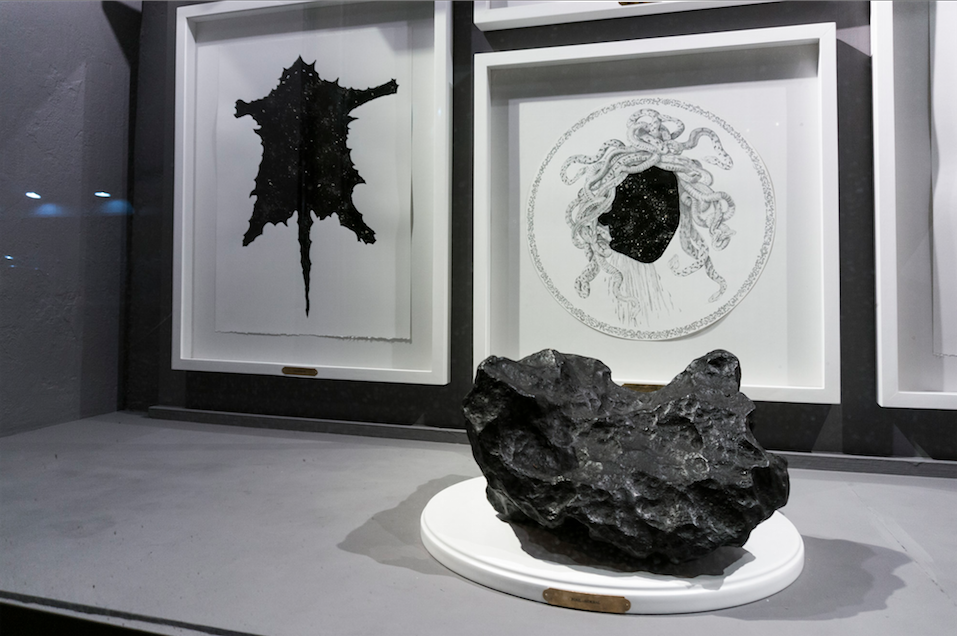Gabinete # 10
Astrum: sideral, Corpore: cuerpo
(las estrellas en el cuerpo).
Lina Mazenett y David Quiroga, artistas colombianos, trabajan como colectivo desarrollando proyectos a través de diversos medios, pero siempre centrados en la idea de cómo ver el tiempo. Sus trabajos parten y se valen de disciplinas como la geología, la astronomía y la historia. Tal es el caso Astrum in corpore, décimo Gabinete de FLORA que hace referencia a la célebre caída de un meteorito en Boyacá en 1810; cuerpo celeste que actualmente pertenece al Departamento de Geología de la Universidad Nacional de Colombia.
El meteorito es testigo de sucesos del cielo, son la “forma primera”, el origen y la manifestación de un tiempo incalculable, un tiempo que nos sobrepasa y nos antecede. Las civilizaciones antiguas creían que el cielo era de roca y los meteoritos (betilos, piedras sagradas), eran la prueba de desprendimientos de ese cielo.
Astrum in corpore está compuesto por una pieza escultórica consistente en un vaciado en brea de un meteorito a escala natural; cuatro dibujos realizados con pintura bituminosa mezclada con distintos minerales como cuarzo, aluminio y pirita; y dos esculturas de amonitas realizadas en grasa animal.
La brea, materia fósil que se extrae de las profundidades de la tierra, es el resultado de la sedimentación de millones de años de restos animales y vegetales. De esta forma, la materialización del meteorito en brea es un gesto que permite unir temporalidades distantes en un solo cuerpo, la manifestación del tiempo universal en nuestro tiempo terrenal.
La figuras en los dibujos hacen referencia al espacio celeste en distintas mitologías: la piel de jaguar simboliza el cielo estrellado en ciertas culturas mesoamericanas; el caparazón de tortuga es leído como bóveda celeste en la cultura oriental; el cerebro humano remite a Paracelso para quien el hombre es un microcosmos y la bóveda cerebral corresponde a la bóveda celeste; y la Medusa se relaciona con la idea de la infinitud del abismo en la mitología Griega.
Las piezas presentadas en Astrum in Corpore son reflejo entre el arriba y el abajo y su relación con la idea del cielo como una construcción mental y cultural que atañe a nuestra condición humana.
—
Astrum: sidereal, Corpore: body
(the stars on the body).
Lina Mazenett and David Quiroga are Colombian artists, working collectively, developing projects through different ways, but always focused on the idea of how to look at time.
Mazenett and Quiroga make use of disciplines such as geology, astronomy and history. This is the case of Astrum in Corpore, tenth FLORA’s Cabinet, which refers to the famous meteorite fall in Boyacá in 1810. This celestial body currently belongs to the Department of Geology at the National University of Colombia.
Meteorites are witnesses of events from heaven, they are the “first form”, the origin and manifestation of an incalculable time, one that existed before humans and surpasses them. Ancient civilizations believed that the sky was made of rock, and therefore meteorites could be seen as the living proof.
Astrum in corpore includes a full-scale sculptural piece made of tar; four drawings made with bituminous paint mixed with other minerals such as quartz, aluminum and pyrite; and two sculptures of fossil ammonites made of animal fat.
Tar, a fossil material that is extracted from the depths of the earth, is the result of sedimentation of millions of years of animal and plant matter. The materialization of the meteorite sculpture in tar is a gesture that links distant temporalities in one single body, the manifestation of universal time in human, earthly time.
The figures in the drawings refer to idea of celestial space in different mythologies: the jaguar skin symbolizes the starry sky in certain Mesoamerican cultures; the turtle shell represents the sky in some Eastern cultures; the human brain refers to Paracelsus to whom the human being is a microcosm and the cranial vault corresponds to the celestial vault; and Medusa relates to the idea of the infinity of the abyss in Greek mythology.
The pieces presented in Astrum in Corpore are the mirror between the sky and earth, and its relationship with the idea of heaven as a mental and cultural construction in the human condition.
